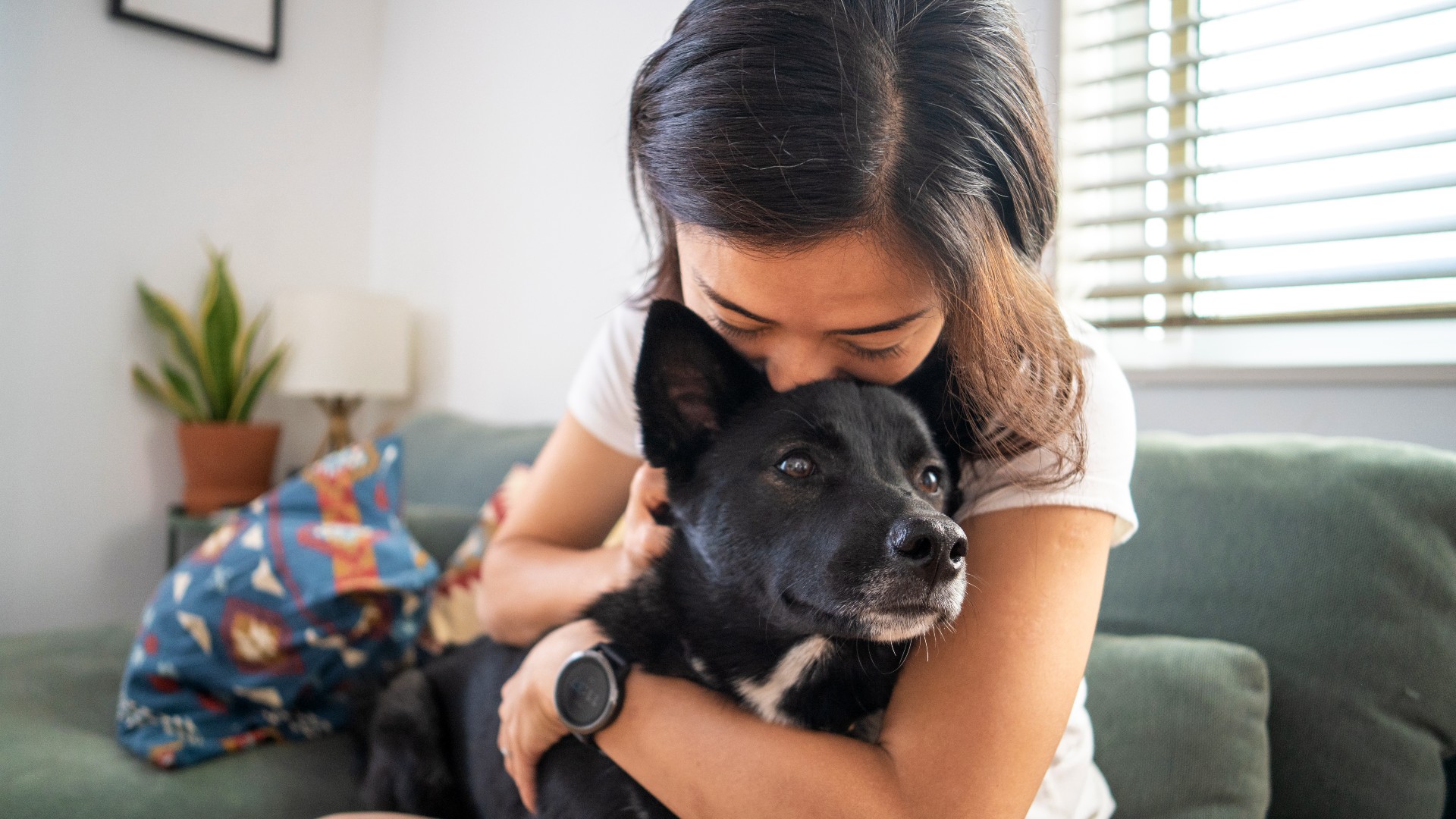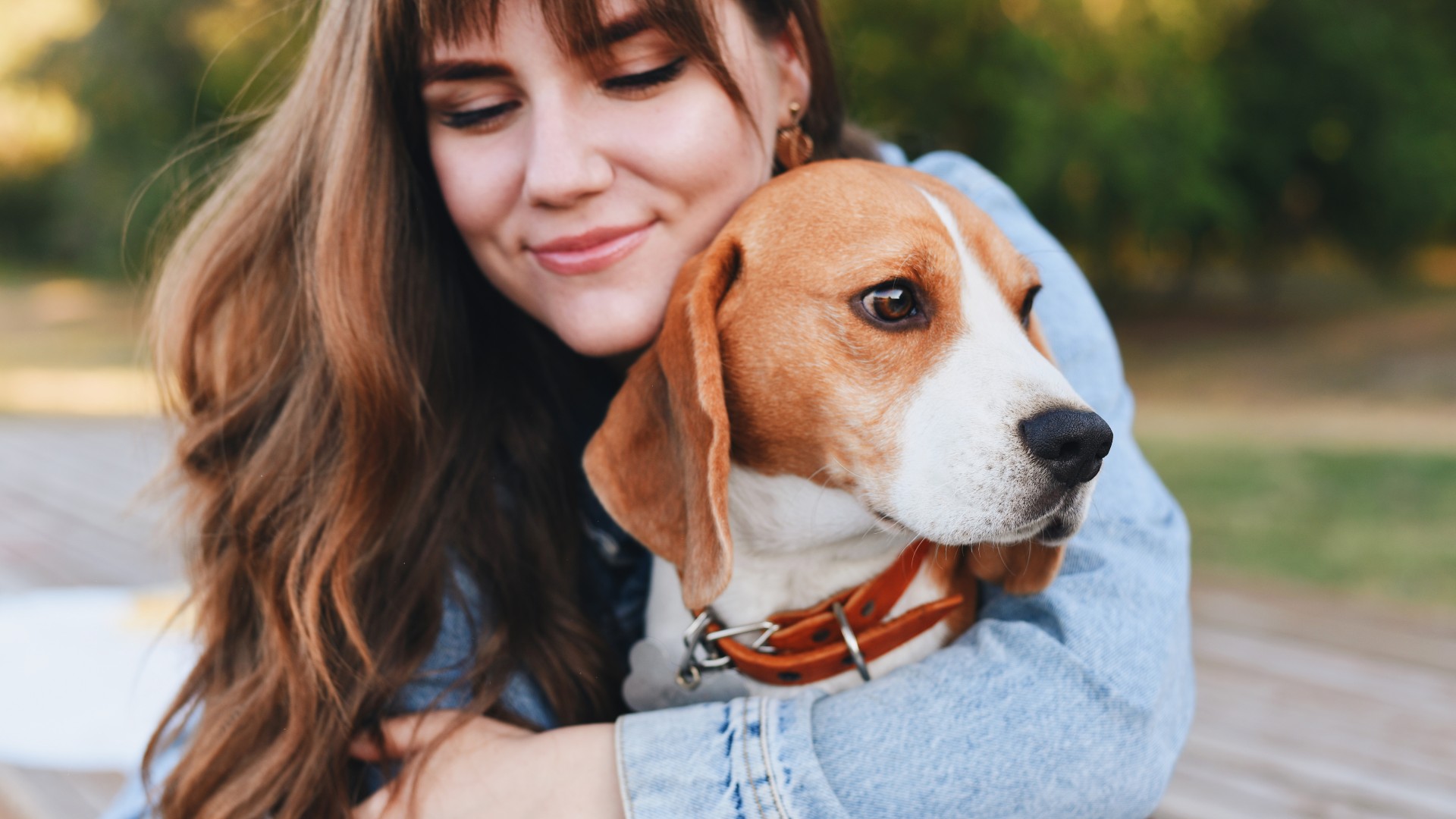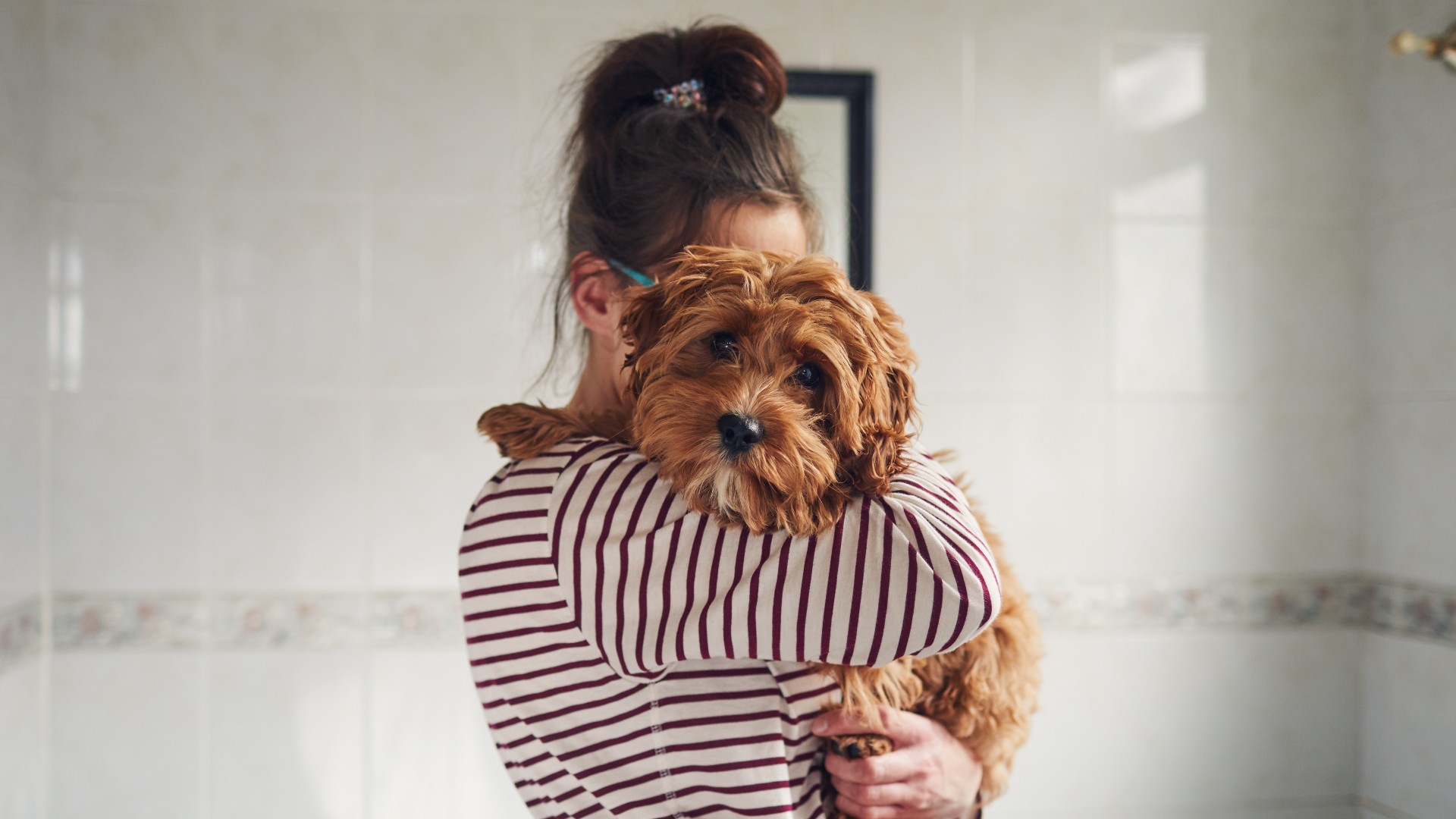Can hugging a dog stress them out? The pros and cons of cuddling your canine
While hugging a dog can offer huge benefits to our physical and mental health, research shows it can actually increase stress and anxiety in our furry friends

Hugging a dog has been scientifically proven to offer humans a host of physical and mental health benefits, but when it comes to whether regular cuddles are good for our canine companions, the findings are much less clear.
While regular play sessions have long been shown to offer our pups the daily body and brain boosting workout they need to stay happy and healthy, those frequent snuggle sessions may just have the opposite effect.
It’s normal for humans to greet each other and show affection by giving one another a warm hug, but if you watch your dog closely, you'll notice they communicate very differently.
Although some animals, like the chimpanzee, are known to hug each other as a way of showing love, dogs are not one of them. Instead, our furry friends say hello to one another by sniffing each other's bottoms and the only time they’ll pin each other down is when they’re either play fighting or real fighting.
Even the most affectionate dog breeds may not enjoy being hugged. For them, being curled up next to you or on your lap or following you around like your second shadow is likely how they feel comfortable giving and receiving love and closeness.
That’s not to say that your dog won’t tolerate a small hug or that you can’t train them from when they’re a puppy to find the whole process more enjoyable, and there are certainly benefits to be had to both of you from a daily hug, but it is worth remembering that this is unlikely going to be your pup’s preferred method of bonding with you.
Below, we walk you through the pros and cons of hugging your dog, the signs to look out for that signal your fur baby is feeling uncomfortable and some canine-friendly ways that you can show your affection.
Get the best advice, tips and top tech for your beloved Pets
- 10 signs your dog loves you
- Why do dogs bring you toys and other gifts?
- Which love language does your pet speak?
Reasons why you should hug your dog
Several studies in recent years have shown that hugging your dog on a regular basis can benefit you in a range of important ways, here are a few of our favorites:
1. It’s good for your physical health - and possibly your dog’s
When you hug your dog, your body releases the love hormone oxytocin. Known to produce feelings of happiness and trust, oxytocin can also inhibit the stress hormone cortisol, which is a good thing as too much cortisol can lead to a range of health issues including weight gain, reduced immune function, fatigue and depression.
This calming effect that the release of oxytocin has on the body when we hug our pets has also been shown in a study published in Circulation: Cardiovascular Quality and Outcomes to lower our heart rate and blood pressure, resulting in a reduced risk of death from cardiovascular disease by as much as 21%.
The health benefits of hugging for dogs are slightly less clear, but what we do know is that our canine companions are pack animals who need physical touch and bonding to be happy. While frequent cuddles may not be the answer, being without human or fellow canine contact can create physical and emotional stress.
2. Helps to relieve depression and anxiety
According to the World Health Organization, depression is now the leading cause of disability worldwide, with anxiety sitting at number six. That puts depression ahead of all physical illnesses, including cancer and heart disease. Pretty scary, right?
But the good news is, owning a pet and hugging them has been proven to reduce anxiety and depression by lowering the amount of cortisol that’s circulating in the body at any one time. The less cortisol you have pumping through you the happier, calmer and more relaxed you feel.
Dogs do a wonderful job of picking up on when their humans are feeling low or distressed and are quick to offer comfort in the form of staying close, snuggling up next to their owner or sitting on their lap. Not only are they a great natural remedy for anxiety and depression, they help reduce feelings of loneliness too.
3. It can strengthen your bond
If your dog doesn’t mind a daily cuddle or two, those regular hugs can help the two of you to grow closer and cement the strong bond that you share.
As we mentioned earlier, hugging releases the hormone oxytocin, which, providing your dog is enjoying the experience and isn’t stressed by it, will be released in them as well. When oxytocin is circulating in our bodies, we feel that much closer and more connected to each other, so it’s a great way of deepening your relationship.
4. Regular hugs help you to stay in tune with your pet’s health
Another fantastic reason to hug your dog regularly is that it allows you to monitor their health in a way that you can’t quite do from a distance. Cuddling your canine companion will enable you to quickly notice any changes, such as new and unusual lumps, unpleasant smells or any areas that seem sensitive to the touch that could indicate an injury or health issue.
Being in tune with your dog’s body means that should you notice anything out of the ordinary, you’ll be able to contact your vet immediately and get your forever friend checked over to make sure everything is okay.

Reasons why you shouldn’t hug your dog
While there is some compelling evidence for hugging your dog, most of the benefits skew toward the human side, with research demonstrating that hugs may actually be detrimental to your dog’s mental health.
Let’s take a look at some of the top reasons why hugging your dog is best avoided:
1. Your dog doesn’t understand what’s happening
Our furry friends didn’t grow up being socialized to hug like we humans did and they certainly never learned that this is a sign of affection, so what we view as a loving action designed to shower those we care about with affection, our canine companions likely see as our attempt to restrict and constrain them.
It’s important to understand that dogs do not like to be restricted. Part of a group known as cursorial animals, dogs adapted specifically to run and so they’re hardwired at a primal level to want to move frequently and swiftly. Being constrained makes them feel threatened because having limited mobility puts them at risk of predators.
2. They can quickly become overstimulated
Dogs can become overstimulated much more quickly than humans and because we’re essentially trapping them when we’re hugging them and they have no way of escaping, the whole situation can trigger a stress response.
Couple that with the fact our hugs are normally accompanied by some rather intense eye gazing and putting our faces right up next to our dog’s and you can see how this whole snuggling scenario can feel both scary and threatening to our forever friends.
3. Dogs don’t like hugs
In 2016 psychology professor and neuropsychological researcher Stanley Coren studied over 250 photos of dogs being hugged and what he discovered confirms the theory that the majority of our canine companions do not like to be hugged.
Coren noticed in the photos that an overwhelming number of the dogs (around 81%) were clearly displaying signs of increased stress and anxiety while being hugged, including lowering their ears and avoiding eye contact. Whale eyes in dogs (when you can see the white’s of your pup’s eyes) is also a very common indicator of stress.
“A lot of dog professionals would agree that hugging a dog is non-ideal,” dog-cognition scientist Dr. Alexandra Horowitz told Insider. “I’ve never seen a dog who—when you hug them—they stand up and wag their tail and they’re so excited. They do something else. They deal with it, you know?
The reason we say they don’t like being hugged is because of what they look like when you’re hugging them,” Horowitz says.
“They pin their ears back, they lick their lips (sort of air licking). Or they yawn, which is another stress behaviour. Or they move to get away. Or they show this kind of whale-eye posture — you can see the whites of their eyes. They show behavior that means ‘This is uncomfortable.”
4. They may bite
Even the most placid, loving, gentle and docile dog may bite when it’s feeling stressed and uncomfortable, so unless you know for sure that your dog enjoys being hugged, it’s best avoided.
Even if your pup tolerates your hugs, they may not take so kindly to a stranger or child doing the same, so make sure this is avoided and teach any young children how to interact with your dog in order to keep them safe.
Signs your dog is uncomfortable
If you’re unsure whether your dog is enjoying those daily cuddles or if they’re actually proving to be a source of anxiety, here are some signs you can look out for that indicate your dog is uncomfortable with that level of affection:
- A stiff body
- Head turned away (no eye contact)
- Whale eye
- Ears lowered
- Tail tucked
- Yawning
- Licking their lips or nose
- A raised paw
- Serious signs, such as growling or baring their teeth
Pay attention to your dog’s body language when you’re hugging them and if you notice any of the above signs, stop the hug immediately.

Canine-friendly ways to show your affection
There’s certainly the possibility that you can train your dog from a young age to tolerate hugs, but it’s worth remembering that this is highly unlikely to ever be their preferred way of receiving love and affection. With that in mind, here are some canine-friendly ways that you can show your dog some love:
- Treat them to a grooming session - grab the best dog brush and a pair of dog nail clippers and spend an afternoon pampering your pooch
- Give them a good belly rub - dogs love having their tummy rubbed and their back and legs scratched, so feel free to pet them until your heart's content. Just avoid touching their head, as they dislike this almost as much as they dislike hugs
- Play a game - whether it’s fetch, tug-of-war, or one of the many indoor games for dogs, there’s nothing our furry friends love more than having fun with their humans
- Challenge your mutt’s mind - alongside physical games, it’s also super important to give your pup a good mental workout. Why not try one of our favorite brain games for dogs or invest in one of the best puzzle toys to help expand those craniums and keep your canine companion mentally stimulated
- Give them a food reward - nothing quite says ‘I love you’ like a few of the best dog treats. As long as these make up 10% or less of your dog’s daily diet, they can be a great way of showing your pup affection in a way that they can understand.
While we understand how wonderful hugging your canine companion can be, it's important to remember that our furry friends like to give and receive love and affection in different ways than we humans do.
By implementing some of the suggestions in the list above, you'll be ensuring that you're speaking your dog's love languages - something that they'll truly appreciate.

Kathryn is a freelance writer who has been a member of the PetsRadar family since it launched in 2020. Highly experienced in her field, she's driven by a desire to provide pet parents with accurate, timely, and informative content that enables them to provide their fur friends with everything they need to thrive.
Kathryn works closely with vets and trainers to ensure all articles offer the most up-to-date information across a range of pet-related fields, from insights into health and behavior issues to tips on products and training.
When she’s not busy crafting the perfect sentence for her features, buying guides and news pieces, she can be found hanging out with her family (which includes one super sassy cat and a kitten), drinking copious amounts of Jasmine tea and reading all the books.
She has written for a range of publications, including Fit&Well, Top Ten Reviews, LiveScience, Goodto, and Product Hunt.
